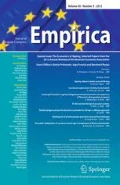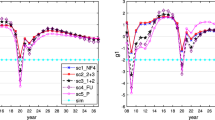Abstract
We analyse the policy of an independent central bank in a monetary union. The monetary policy equilibrium, prevailing under either discretion or commitment, is analogous to the one country case, although the stabilization policy is less than optimal for each single country in the monetary union. The extent of optimality of the monetary rule changes with the cross-country heterogeneity in economic shocks. Heterogeneity of preferences implies, that in a dynamic setting there is variation in the incentives of each member country. A country with a low target level of output or output cost weight might not reap any benefit from a deviation from the commitment equilibrium. The commitment policy can be enforced with a proper definition of the inflation expectations rule. With homogeneous preferences the advantages and disadvantages of the monetary union commitment policy relatively to the own discretionary one, for any new candidate or existing member country, are a function of its relative size and degree of asymmetry.
Similar content being viewed by others
Notes
In a general equilibrium framework the target levels of output and the output cost weights could be defined for each member country from features of consumer preferences. A broad review of the relation between instruments, targets and objectives is provided in Woodford (2003).
A condition of identical parameters across countries could follow from the assumption, that loss functions are assigned to each country and the monetary authority at an initial institutional design stage, as for instance in Rogoff (1985).
The perfectly asymmetric case obtains, when the monetary union member countries can be partitioned in an even number of groups, with equal sets of equivalent country weights between pairs of groups and with observable shocks perfectly positively correlated within each group and perfectly negatively correlated across groups in each pair.
In the field of game theory trigger strategies of the type in Eq. (14) have been used by Friedman (1971), Fudenberg and Maskin (1986) and Abreu et al. (1994), in order to prove the existence of subgame perfect equilibria as the one above described. We note, that the application of choice by majority rule is not a desirable solution in the present model, since the target levels of output and the output cost weights of each member country are common knowledge at the ex ante stage. The benefits of majority voting as a social choice rule require in general a condition of anonymity to be satisfied, a review can be found in Dasgupta and Maskin (2008). An interesting alternative perspective is provided by the Dixit (2000) model, where the optimal commitment rule is derived taking into account of the incentive compatibility constraints of each country.
With equal target levels of output and output cost weights the expressions for the expected benefit and cost of a deviation from the announced monetary policy rule in period t are equal to the corresponding ones provided by Alesina and Stella (2011), for the single country case without exogenous shocks. This finding is due to the assumption, that the demand or supply and purchasing power parity shocks have zero means and identical variances and covariances over time.
The above analysis also implies, that a country able to enforce the optimal own commitment policy would not have an advantage to participate in the monetary union. The expected cost of the own monetary rule is equal to zero in this case and the expected benefit of the own stabilization term or the expected cost of the monetary union one are the same.
Currency crises have historically taken several forms, ranging from banking to public debt crises. In the context of the EMU we should recall, that the euro conversion rate is irrevocable for any participating member country. Following the Lisbon Treaty in 2007 any EU country has the right to withdraw from the union.
References
Abreu D, Dutta PK, Smith L (1994) The folk theorem for repeated games: a neu condition. Econometrica 62(4):939–948
Alesina A, Barro RJ (2002) Currency unions. Q J Econ 117(2):409–436
Alesina A, Stella A (2011) The politics of monetary policy. In: Friedman BM, Hahn FH (eds) Handbook of monetary economics, vol 3B. North Holland, Amsterdam, pp 1001–1054
Alesina A, Tabellini G, Trebbi F (2017) Is Europe an optimal political area? Brookings Pap Econ Act 2017(1):169–234
Barro RJ, Gordon DB (1983a) A positive theory of monetary policy in a natural rate model. J Polit Econ 91(4):589–610
Barro RJ, Gordon DB (1983b) Rules, discretion and reputation in a model of monetary policy. J Monet Econ 12(1):101–121
Dasgupta P, Maskin E (2008) On the robustness of majority rule. J Eur Econ Assoc 6(5):949–973
Dixit A (2000) A repeated game model of monetary union. Econ J 110(466):759–780
Fischer S (1990) Rules versus discretion in monetary policy. In: Friedman BM, Hahn FH (eds) Handbook of monetary economics, vol 2. North Holland, Amsterdam, pp 1155–1184
Friedman JW (1971) A non-cooperative equilibrium for supergames. Rev Econ Stud 38(1):1–12
Fudenberg D, Maskin E (1986) The folk theorem in repeated games with discounting or with incomplete information. Econometrica 54(3):533–554
Kydland FE, Prescott EC (1977) Rules rather than discretion: the inconsistency of optimal plans. J Polit Econ 85(3):473–492
Mundell RA (1961) A theory of optimum currency areas. Am Econ Rev 51(4):657–665
Obstfeld M (1996) Models of currency crises with self-fulfilling features. Eur Econ Rev 40(3–5):1037–1047
Persson T, Tabellini G (1999) Political economics and macroeconomic policy. In: Taylor JB, Woodford M (eds) Handbook of macroeconomics, vol 1. Elsevier, Amsterdam, pp 1397–1482
Persson T, Tabellini G (2000) Political economics: explaining economic policy. The MIT Press, Cambridge
Rogoff K (1985) The optimal degree of commitment to an intermediate monetary target. Q J Econ 100(4):1169–1189
Spolaore E (2015) The political economy of European integration. In: Badinger H, Nitsch V (eds) Routlege handbook of the economics of European integration. Routlege/Taylor & Francis Group, London, pp 435–448
Woodford M (2003) Interest and prices: foundations of a theory of monetary policy. Princeton University Press, Princeton
Acknowledgements
The views expressed herein are those of the author and not necessarily those of the Bank of Italy.
Author information
Authors and Affiliations
Corresponding author
Additional information
Publisher's Note
Springer Nature remains neutral with regard to jurisdictional claims in published maps and institutional affiliations.
Appendix: Proofs of statements
Appendix: Proofs of statements
We provide the basis for the monetary policy equilibrium in the monetary union model, with alternative assumptions about the institutional constraints on the behaviour of the monetary authority.
Conditional on the institutional constraints, the monetary policy equilibrium is determined under the assumption of rational expectations. In each model the monetary policy rule is defined as a function of the realized values of the demand or supply shocks.
In the discretionary equilibrium the monetary authority chooses in each time period the average inflation rate \(\pi _{t}\), in order to minimize the loss function (4) subject to (1)–(3) and to the rational expectations constraint that the expected inflation rate in each country is equal to the average expected inflation rate: \(E_{t} \left( \pi _{i t}\right) =E_{t} \left( \pi _{t}\right)\) for all \(i =1 ,\ldots ,n\). In addition, under discretion the optimal monetary rule is determined in each period conditional on inflation expectations.
The first order condition for the central bank optimization problem is the following:
Since the expected value of the purchasing power parity shock \(\upsilon _{i t}\) for \(i =1 ,\ldots ,n\), conditional on information available in period t, is by assumption equal to zero, solving Eq. (29) for the average inflation rate \(\pi _{t}\) yields Eq. (5). The assumption of a quadratic loss function implies moreover, that the second order condition is satisfied.
In the commitment equilibrium the central bank selects a monetary policy rule of the form \(\pi _{t} =\pi \left( \varepsilon _{1 t} ,\ldots ,\varepsilon _{n t}\right)\), to minimize the loss function (4) subject to (1)–(3) and to the rational expectations constraint \(E_{t} \left( \pi _{t}\right) =E_{t} \left[ \pi \left( \varepsilon _{1 t} ,\ldots ,\varepsilon _{n t}\right) \right]\). In order to derive the optimal commitment rule, we use the linear properties of the conditional expectation operator. Denote respectively with \(F \left( \varepsilon _{1 t} ,\ldots ,\varepsilon _{n t}\right)\) and \(G \left( \upsilon _{1 t} ,\ldots ,\upsilon _{n t}\right)\) the period t distributions of the demand or supply shocks and of the purchasing power parity shocks. Since the demand or supply shocks and the purchasing power parity shocks are assumed to be stochastically independent, the central bank loss function resulting from Eqs. (1)–(4) takes the form:
and the rational expectations constraint is:
Substituting the rational expectations constraint (31) in the loss function (30), the first order condition for the central bank optimization problem can be represented as follows:
Computing the integrals in Eq. (32) leads to the condition:
where as before \(b =\sum _{i =1}^{n}w_{i}b_{i}\) is the weighted average of the output cost weights, \(\varepsilon _{t} ={\displaystyle \sum\nolimits _{i =1}^{n}}\omega _{i} \varepsilon _{i t}\) is the weighted average of the demand or supply shocks in period t, compiled using the equivalent set of weights, and the equivalent weights are defined as \(0 \le \omega _{i} =w_{i}b_{i}/b \le 1\), \(\sum _{i =1}^{n}\omega _{i} =1\).
The rational expectations constraint and Eq. (33) in turn imply, that in equilibrium \(E_{t} \left( \pi _{t}\right) =0\) in each period t. Substituting this result in Eq. (33) yields the optimal commitment monetary policy rule (10). We note again, that the assumption of a quadratic loss function implies, that the second order condition for the central bank optimization problem is fulfilled.
Rights and permissions
About this article
Cite this article
Tomat, G.M. Central bank policy in a monetary union with heterogeneous member countries. Empirica 48, 759–773 (2021). https://doi.org/10.1007/s10663-020-09485-3
Published:
Issue Date:
DOI: https://doi.org/10.1007/s10663-020-09485-3




